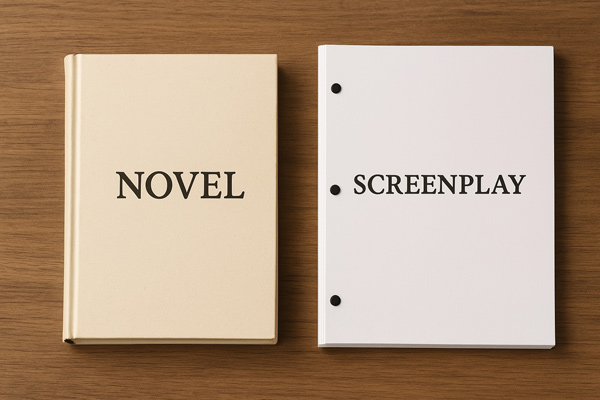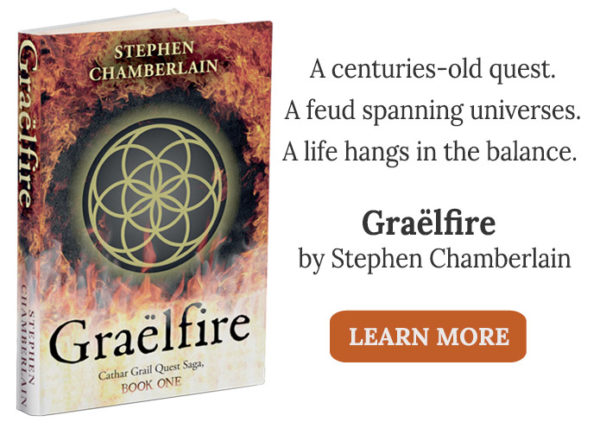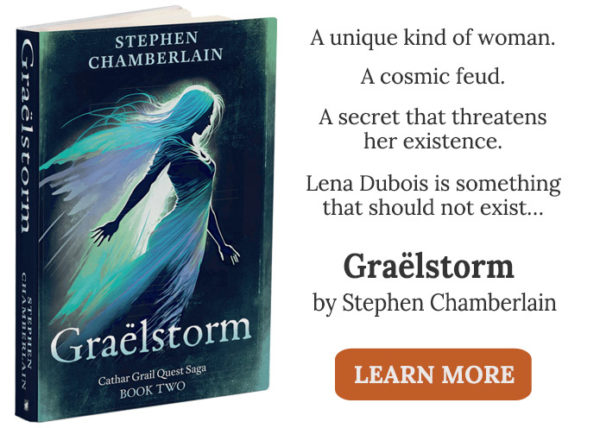“Books and movies are like apples and oranges. They both are fruit, but taste completely different.” – Stephen King
When I was working on my first novel, Graëlfire, I asked a novelist-cum-screenwriter to copyedit an early version of my manuscript. I wanted feedback on my handling of exposition, a tricky job in fantasy and sci-fi. World-building elements are crucial, but all that setting, magic, culture, myth, and backstory can bog down a story when delivered in large chunks.
I thought I’d blended my exposition seamlessly into action and dialogue, but the editor showed me how much I could trim. They encouraged me to think visually, rely more on subtext, and trust readers to fill in the blanks. That insight sparked my interest in studying movie scripts. Writing novels and scripts are entirely different crafts, each with its own strengths and demands. Here’s a look at what screenplays can teach novelists about storytelling.
Less Can Be More
A common screenwriting rule is that a page of script reflects one minute of screen time. That means a feature film script has just 90 to 120 pages to carry the entire story. The text itself is sparse, broken into beats, and the page shows much more white space than ink because a script is built almost entirely from short, punchy dialogue. With such tight limits, every scene must advance the plot, reveal character, or raise the tension. There’s no space for filler. Novelists benefit from this mindset by asking: Why is this scene here? What changes by the end of it? Is the momentum bogged down by too much detail?
Take chapter four of Harry Potter and the Philosopher’s Stone—Harry’s first encounter with Hagrid in the storm-battered shack—and compare it to the movie adaptation. In the book, Hagrid breaks the door down with a smash and stands towering in the doorway—a wild, bearded giant with eyes glinting like black beetles. Such a sight would terrify anybody, but a full page passes before we get Harry’s reaction. Even then, it’s only to take the birthday cake Hagrid offers him “with trembling fingers.” The pace stalls as Hagrid rummages through his pockets, pulling out sausages, a copper kettle, a poker, several chipped mugs, etc. He makes tea and cooks the sausages, and it’s not until several pages into the chapter that Hagrid finally gets to the point of the scene—telling Harry he’s a wizard and delivering his invitation to Hogwarts.
I understand the goal of this content. It builds atmosphere and establishes Hagrid’s magical nature. But there’s a lack of momentum and emotion after his dramatic entrance. The movie screenplay—Harry Potter and the Sorcerer’s Stone—takes a different approach. The same scene is much more streamlined: a thunderous knock, a quick exchange, a spark from Hagrid’s folded umbrella lighting the fire—which doesn’t appear in the book—and then straight to the point:
[Suddenly, the door thumps, in sync with the thunder flashing. Harry jumps. The door thumps again and Dudley and Harry jump up and back away. Harry hides behind a wall, and Dudley cowers on a windowsill. Petunia and Vernon appear, with Vernon holding a double barrel gun.]
A few more lines of dialogue follow before:
[Hagrid sits down on the sofa, takes out an umbrella, and points it at the empty fire. Two sparks fly out of the umbrella and start a fire. The Dursley family gasps.]
Harry (putting the cake down): Excuse me, who are you?
Hagrid: Rubeus Hagrid, Keeper of Keys and Grounds at Hogwarts. O’ course, yeh’ll know all about Hogwarts.
Harry: Sorry, no.
Hagrid: No? Blimey, Harry, didn’t you ever wonder where yer mum and dad learned it all?
Harry: Learnt what?
Hagrid: Yer a wizard, Harry.
After another short exchange, Hagrid hands Harry a letter:
Dear, Mr. Potter. We are pleased to inform you that you have been accepted at Hogwarts School of Witchcraft and Wizardry…
The screenplay is concise—about a page—offering minimal explanation. The pacing is fast and uncluttered. Dialogue is clipped and realistic. In short, it doesn’t beat about the bush—Harry’s a wizard and he’s going to Hogwarts.
Show, Don’t Tell
This extract shows how screenplays focus on dialogue and a few actions or gestures. There are no feelings or thoughts. Actors convey emotion and atmosphere onscreen through their performance, which creative camera work and the movie’s soundtrack can enhance. These elements speak volumes without a single word being spoken.
The tea-making scene in the book paints Hagrid’s magical charm with amusing detail, but the film uses a single image—the enchanted umbrella—to convey the same thing. You don’t need to explain it. This efficiency in storytelling is something novelists can borrow. It sharpens pacing and heightens emotion. It teaches them how to show more, tell less—and leave a stronger impact with fewer words.
My current work in progress is a character-driven supernatural fantasy set in the heart of a Scandinavian winter, where an ancient myth refuses to stay buried. For the first time, I began writing my story in screenplay format, forcing the plot and conflict to unfold almost entirely through dialogue. That discipline allowed me to get the plot down on paper quickly, in just 25,000 words. After that, I went back and added visual cues to externalize the characters’ emotions and reactions. Only then did I transform the manuscript into prose, layering in richer mythmaking, fuller scene-building, and the point-of-view character’s perspective—their thoughts, impressions, opinions, sensations, feelings, hopes, desires, memories, and regrets. This POV character is the subjective filter that shapes how the reader experiences the story, turning raw events into a personal narrative. For me, that was the most satisfying stage, and the result is a fully realized novella of 35,000 words—a perfect medium for a supernatural tale that thrives on concentrated atmosphere, sustained tension, and the clarity that comes from the absence of distracting subplots.
Apples and Oranges
Novels and screenplays are different mediums of storytelling. Screenplays aren’t meant to be read like novels. They are functional tools to guide a production. That’s why reading them feels flat and emotionally thin. It’s up to the actors, director, and production crew to make the dialogue come alive through facial expressions, gestures, vocal tone, soundtrack, and vivid cinematography.
Novels live and die by the quality of their prose. Where screenwriters sketch an outline for others to fill, novelists must paint the full picture, delving deep into setting, world building, backstory and what’s going on inside a character’s head.
Despite their differences, reading scripts can teach a novelist the discipline of making every word count. Here are my takeaways:
- Think in Scenes
Screenplays are built scene by scene. Each one has a purpose—heightening conflict, revealing character, or advancing the plot. If a scene doesn’t earn its place, it’s cut. Novelists can use the same test: does this chapter serve a purpose? If not, trim it. - Show, Don’t Tell
Screenwriters can’t write,“She was lonely.”They must express or show it—a character eating alone to the sound of a ticking clock, coming home to an empty house and pausing on the threshold, a glance at a phone with no messages. Novelists should steal this trick: let action, setting, and dialogue carry the emotion. It’s more immersive for the reader. - Keep Exposition Lean
Movies don’t pause for three pages of backstory. They reveal enough when it matters. Novels work best the same way—sprinkle it in the background, don’t dump it. - Push the Plot Forward
Screenplays run on momentum. Every scene ends with tension, a choice, or a hook into the next. If your novel drags, think like a screenwriter and amp up the stakes to keep pages turning. - Make Dialogue Work Overtime
In film, dialogue must reveal characteranddrive the plot. Every line counts. Novelists should use the same standard: if a line doesn’t earn its spot, cut it.
If you’re a writer interested in learning from screenwriting, here are a couple of reliable sources:
www.imsdb.com
www.scriptslug.com



